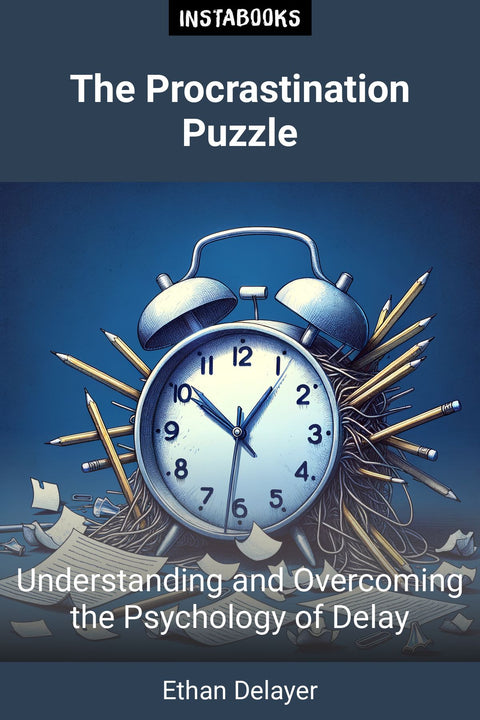
The Procrastination Puzzle
Understanding and Overcoming the Psychology of Delay
Included:
✓ 200+ Page AI-Generated Book
✓ ePub eBook File — read on Kindle & Apple Books
✓ PDF Print File (Easy Printing)
✓ Word DOCX File (Easy Editing)
✓ Hi-Res Print-Ready Book Cover (No Logo Watermark)
✓ Full Commercial Use Rights — keep 100% of royalties
✓ Publish under your own Author Name
✓ Sell on Amazon KDP, IngramSpark, Lulu, Blurb & Gumroad to millions of readers worldwide
AI Book Preview
Below you'll find a comprehensive preview of all chapters in this book. Each section provides a glimpse into the key concepts, practical insights, and valuable knowledge you'll gain.
Chapter 1: The Roots of Procrastination
The Emotional Triggers Behind Delay
Procrastination often stems from emotional responses like fear of failure, perfectionism, or anxiety, which create mental barriers to action. By identifying and addressing these triggers, you can break the cycle of delay and regain control over your time and goals.
Fear of Failure and Its Impact
Fear of failure often paralyzes progress, creating a cycle of avoidance that reinforces procrastination. This section explores how this fear manifests, its psychological roots, and practical strategies to break free from its grip.
The Role of Self-Control
Self-control plays a pivotal role in overcoming procrastination, acting as the bridge between intention and action. By understanding how self-regulation works and identifying its limitations, you can develop strategies to strengthen your willpower and break free from the cycle of delay.
Chapter 2: The Mental Health Connection
Procrastination and Anxiety
Procrastination often stems from anxiety, creating a cycle where fear of failure or perfectionism paralyzes action. Understanding this connection reveals practical strategies to break free and foster healthier, more productive habits.
Depression and Chronic Delay
Chronic procrastination is often deeply intertwined with depression, creating a cycle of avoidance and emotional distress. This section explores how identifying and addressing depressive patterns can break the grip of delay and foster healthier productivity habits.
Self-Esteem and Procrastination
Low self-esteem often fuels procrastination by creating a fear of failure and self-doubt, leading to avoidance behaviors. This section explores how building self-confidence and reframing negative thought patterns can break the cycle of delay and foster productivity.
Chapter 3: Breaking the Cycle
Setting Specific and Realistic Goals
Setting specific and realistic goals is the cornerstone of breaking the procrastination cycle, as it transforms vague intentions into actionable steps. You’ll discover how to craft goals that align with your priorities, reduce overwhelm, and foster consistent progress.
Emotional Regulation Techniques
Emotional regulation techniques empower you to manage stress and negative emotions, breaking the cycle of procrastination by fostering resilience and focus. You’ll discover practical strategies to identify, process, and transform emotional triggers into productive energy.
Prioritization and Time Management
Mastering prioritization and time management is essential for breaking the cycle of procrastination by aligning your actions with your most meaningful goals. Discover practical strategies to focus your energy, eliminate distractions, and create a sustainable routine that fosters productivity and reduces overwhelm.
Chapter 4: The Science of Motivation
Understanding Intrinsic and Extrinsic Motivation
Understanding the difference between intrinsic and extrinsic motivation is crucial for unlocking sustained productivity and overcoming procrastination. This section explores how internal passions and external rewards shape our actions, offering practical insights to harness both for lasting change.
The Role of Rewards and Punishments
Rewards and punishments shape behavior by tapping into our brain’s reward system, but their effectiveness depends on timing, consistency, and intrinsic motivation. Understanding how to balance external incentives with internal drive is key to breaking the cycle of procrastination.
Building Sustainable Motivation
Sustainable motivation thrives when intrinsic goals align with daily habits, creating a self-reinforcing cycle of purpose and progress. By reframing tasks, embracing small wins, and fostering accountability, you can transform fleeting motivation into lasting momentum.
Chapter 5: Cognitive Tools for Change
Mindfulness and Procrastination
Mindfulness can be a powerful tool to break the cycle of procrastination by helping you recognize and manage the emotions and thoughts that fuel delay. By cultivating present-moment awareness, you’ll learn to approach tasks with greater focus and resilience, reducing the urge to avoid them.
Cognitive Behavioral Techniques
Cognitive Behavioral Techniques empower you to identify and challenge the negative thought patterns fueling procrastination, replacing them with proactive habits and realistic perspectives. By mastering these tools, you can break the cycle of delay and take meaningful steps toward achieving your goals.
Reframing Negative Thoughts
Reframing negative thoughts empowers you to transform self-doubt and fear into actionable, positive perspectives that combat procrastination. By mastering this cognitive tool, you’ll learn to break free from mental barriers and approach tasks with clarity and confidence.
Chapter 6: The Procrastination-Performance Link
Procrastination in Academics
Procrastination in academics often stems from fear of failure, perfectionism, or lack of motivation, leading to decreased performance and increased stress. By identifying these root causes and implementing targeted strategies, students can break the cycle and enhance their academic success.
Procrastination in the Workplace
Procrastination in the workplace often stems from fear of failure, perfectionism, or unclear priorities, leading to missed deadlines and reduced productivity. By identifying these triggers and implementing targeted strategies, employees can reclaim focus, meet goals, and foster a more efficient work environment.
The Impact on Creativity
Procrastination can stifle creativity by disrupting the flow of ideas and increasing pressure, yet strategic delays may sometimes spark unexpected innovation. This section explores how timing and mindset influence the delicate balance between procrastination and creative breakthroughs.
Chapter 7: Social and Environmental Factors
The Influence of Peer Pressure
Peer pressure significantly shapes procrastination behaviors, often leading individuals to prioritize short-term social acceptance over long-term goals. This section explores how social dynamics influence decision-making and provides strategies to resist negative peer influence while staying aligned with personal priorities.
Procrastination and Social Media
Social media's addictive design fosters procrastination by hijacking focus and rewarding instant gratification, making it harder to prioritize meaningful tasks. This section explores how online platforms trigger delaying behaviors and offers strategies to reclaim attention and productivity.
Creating a Productive Environment
Your surroundings have a profound impact on your ability to focus and stay motivated, and by intentionally designing a workspace that minimizes distractions and fosters clarity, you can significantly reduce procrastination. This section explores practical strategies to create an environment that supports productivity, from optimizing lighting and organization to leveraging tools that enhance mental flow.
Chapter 8: Procrastination Across Lifespans
Procrastination in Adolescents
Procrastination in adolescents often stems from a complex interplay of peer influence, academic pressure, and the ongoing development of self-regulation skills. Understanding these factors can help parents, educators, and teens themselves develop effective strategies to manage delay and build healthier habits for the future.
Adult Procrastination Patterns
Adult procrastination often stems from a complex interplay of perfectionism, fear of failure, and overwhelming responsibilities, shaping unique patterns in work and personal life. This section explores how these behaviors manifest, their psychological roots, and actionable strategies to break the cycle.
Procrastination in Later Life
Procrastination in later life is often driven by shifting priorities, health concerns, and the perception of limited time, yet it remains a manageable habit with targeted strategies. Readers will explore how older adults can reframe their approach to tasks and leverage their experience to overcome delays effectively.
Chapter 9: Cultural Perspectives on Procrastination
Procrastination in Different Cultures
Procrastination manifests differently across cultures, shaped by societal norms, attitudes toward time, and collective versus individualistic values. Exploring these cultural nuances reveals how perceptions of delay vary globally and offers fresh insights into managing procrastination in diverse contexts.
Cultural Attitudes Toward Time
Cultural attitudes toward time shape how individuals perceive and engage with procrastination, from the urgency-driven pace of Western societies to the more cyclical, present-focused approaches in other cultures. Understanding these differences reveals how societal norms influence our relationship with deadlines, productivity, and delay.
Global Solutions for Delay
Global perspectives reveal unique cultural strategies to combat procrastination, from Japan's "kaizen" philosophy of continuous improvement to Latin America's emphasis on relational productivity. By exploring these diverse approaches, readers can adapt proven methods to their own lives and overcome delays more effectively.
Chapter 10: Technology and Procrastination
The Role of Digital Distractions
Digital distractions are a primary driver of procrastination, hijacking focus and fragmenting productivity in subtle yet pervasive ways. This section explores how technology fuels avoidance behaviors and offers strategies to reclaim control over attention and time.
Apps and Tools to Combat Procrastination
Discover how innovative apps and tools can transform your approach to productivity by addressing the root causes of procrastination. Learn to leverage technology effectively to stay focused, manage time, and build habits that break the cycle of delay.
Balancing Technology Use
Balancing technology use is essential to prevent it from fueling procrastination, and this section provides actionable strategies to harness its benefits while minimizing distractions. Discover how to create boundaries, prioritize meaningful tasks, and leverage technology as a tool for productivity rather than a source of delay.
Chapter 11: The Future of Procrastination Research
New Directions in Psychological Studies
Emerging psychological research is shifting focus toward the role of emotional regulation and mindfulness in combating procrastination, offering new strategies for long-term behavioral change. Readers will explore cutting-edge studies that reveal how self-compassion and cognitive flexibility can transform the way we approach tasks and manage delay.
Emerging Strategies for Overcoming Delay
Emerging strategies for overcoming procrastination harness cutting-edge psychological insights, technology, and behavioral science to help individuals break free from the cycle of delay. Readers will discover actionable techniques, from gamification to mindfulness practices, designed to foster focus, motivation, and lasting productivity.
The Role of Neuroscience in Understanding Procrastination
Neuroscience is unlocking the brain's mechanisms behind procrastination, revealing how decision-making, emotion regulation, and reward systems influence delay. Understanding these processes offers new strategies to rewire habits and overcome chronic procrastination.
Chapter 12: Your Personal Procrastination Plan
Assessing Your Procrastination Patterns
Understanding your unique procrastination habits is the first step toward breaking the cycle of delay, and this section helps you identify the triggers, behaviors, and thought patterns that hold you back. By analyzing your tendencies, you’ll gain clarity on where to focus your efforts for lasting change.
Creating a Customized Action Plan
Crafting a personalized action plan is essential to break free from procrastination by aligning your goals with your unique motivations and challenges. You’ll discover practical strategies to design a step-by-step roadmap that keeps you focused, accountable, and motivated to take consistent action.
Maintaining Progress and Avoiding Relapse
Maintaining progress requires consistent strategies and self-awareness to prevent old procrastination habits from resurfacing. You’ll discover practical tools to stay on track and build resilience against setbacks, ensuring long-term success in overcoming delay.
Target Audience
This book is written for anyone who struggles with procrastination, including students, professionals, and individuals seeking to improve their productivity and mental health.
Key Takeaways
- Understand the psychological roots of procrastination, including emotional regulation, fear of failure, and self-control.
- Learn how procrastination impacts mental health, from anxiety and depression to self-esteem.
- Discover practical strategies like goal setting, emotional regulation, and prioritization to overcome delay.
- Explore the role of motivation, mindfulness, and cognitive behavioral techniques in breaking the procrastination cycle.
- Gain insights into how social, environmental, and cultural factors influence procrastination habits.
